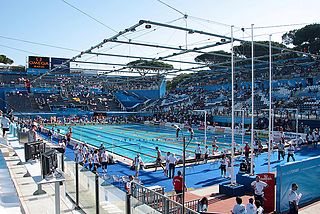
The Gulf of Naples, also called the Bay of Naples, is a roughly 15-kilometer-wide (9.3 mi) gulf located along the south-western coast of Italy. It opens to the west into the Mediterranean Sea. It is bordered on the north by the cities of Naples and Pozzuoli, on the east by Mount Vesuvius, and on the south by the Sorrento Peninsula and the main town of the peninsula, Sorrento. The Peninsula separates the Gulf of Naples from the Gulf of Salerno, which includes the Amalfi Coast.

The Via Cassia was an important Roman road striking out of the Via Flaminia near the Milvian Bridge in the immediate vicinity of Rome and, passing not far from Veii, traversed Etruria. The Via Cassia passed through Baccanae, Sutrium, Volsinii, Clusium, Arretium, Florentia, Pistoria, and Luca, joining the Via Aurelia at Luna.

Turkey competed at the 1960 Summer Olympics in Rome, Italy.

Iran competed at the 1960 Summer Olympics in Rome, Italy. 25 athletes represented Iran in the 1960 Olympics.

Iraq competed at the 1960 Summer Olympics in Rome, Italy. 21 competitors, all men, took part in 23 events in 5 sports. Abdul Wahid Aziz won the nation's only Olympic medal.

The Stadio Olimpico del Nuoto is an aquatics centre at the Foro Italico in Rome, Italy. Inaugurated in 1959, it was designed by the architects Enrico Del Debbio and Annibale Vitellozzi to host the swimming, diving, water polo, and swimming portion of the modern pentathlon events for the 1960 Summer Olympics.

The Acqua Santa Golf Club Course is an Italian golf course located along the Appian Way southeast of Rome.
Campo Tre Fontane is a sports venue located in Rome, Italy. For the 1960 Summer Olympics, it hosted seven field hockey matches.
The Cesano Infantry Shooting Range was a temporary firing range set up by the Italian Army for the infantry off the Via Cassia. It hosted the 300 m free rifle shooting event for the 1960 Summer Olympics in Rome.
The Lazio Pigeon Shooting Stand was a temporary firing range built near the Olympic village in Rome. It was used for the trap shooting event for the 1960 Summer Olympics.

Palazzo dei Congressi(formally: Palazzo dei Ricevimenti e dei Congressi) is a building located in the EUR district of Rome, Italy. The palazzo was designed by Adalberto Libera for the 1942 Universal Exposition. Construction started in 1938 but was cancelled due to World War II. It was completed in 1954.

Passo Corese is an Italian town and hamlet (frazione) of Fara in Sabina, a municipality in the province of Rieti, Lazio. In 2011 it had a population of 3,573.
For the 1960 Summer Olympics, a total of thirty-four sports venues were used. The Basilica of Maxentius, the Baths of Caracalla, the Appian Way, and Via Cassia were among the ancient Roman venues used for the games. The football stadium in Florence hosted the 1934 FIFA World Cup and would later host the 1990 FIFA World Cup. Stadio Olimpico would later serve host to the 1987 IAAF World Championships in Athletics and the final venue for the 1990 FIFA World Cup. The marathon would be lit at night by Italian soldiers holding torches that included the Appian Way with a finish at the Arch of Constantine.









